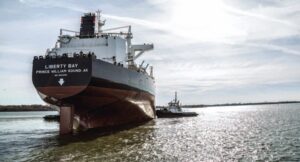
The first of two new SeaRiver oil tankers is expected to begin service in Prince William Sound later this year.
SeaRiver, the shipping arm of ExxonMobil, held a naming ceremony for the vessel Liberty Bay on April 25. The second vessel will be named Eagle Bay.
Built by Aker Philadelphia Shipyard, Inc., both vessels measure 823.5 feet long and 144 feet wide, and have double hull protection for both cargo and fuel tanks. The vessels are capable of carrying 115,000 tons of weight including cargo, fuel, ballast water, provisions and crew. Cargo capacity is 800,000 barrels (approximately 33.6 million gallons). Propelled by a slow speed diesel engine, the vessels’ “service speed” is 15 knots (approximately 17 miles per hour).
Ballast water treatment technology
The ship is equipped with a special onboard system that will use electricity and seawater to treat ballast water for aquatic invasive species, such as European green crab, long of concern to the council. The exterior hull has been treated with a non-tin based anti-fouling coating, which will help prevent the accumulation of non-native organisms such as mussels, barnacles or sea squirts. Older tin-based coatings were especially toxic to the marine environment.
Other safety and environmental features include fall protection equipment when mariners are working at heights greater than 6 feet, a deck rainwater collection system, an oil mist and gas detection system, and a non-halon fire-fighting system.
The main engine and auxiliaries, which conform to the International Maritime Organization’s Tier II standards, are more energy efficient and generate fewer emissions than previous designs. The vessels will use low sulfur diesel fuel for all operations near and in port. Waste heat will be recovered and re-used onboard. Deck lighting is all energy efficient.
Redundant safety and reliability features
Several features increase the reliability of the vessels. The frames of the ship have been specially reinforced to withstand the forces generated by the powerful tugs used in Prince William Sound. Steel piping, the sea chest, and cargo tank sumps have been upgraded beyond minimum standards. Other systems, such as the cooling water system, main engine exhaust valves, and fuel oil tanks’ low level alarms, include redundancy features to improve performance reliability.
“This is an exciting time to be part of SeaRiver,” says Jack Buono, president of SeaRiver. “The $400 million project speaks volumes about the quality of our operation and the confidence our shareholder places in our collective abilities and accomplishments. We look forward to the delivery and deployment of these fine vessels, knowing they will be crewed by the finest mariners and will help serve to meet the energy needs of this great nation safely, reliably and efficiently.”
“The council is very excited to have these new SeaRiver tankers joining the TAPS fleet,” said, Mark Swanson, executive director for the council, “Along with a well proven international commercial design, they herald the arrival of new on-board technology meeting the latest regulatory standards for environmental protection with cleaner fuels and reduced harmful engine air emissions and the treatment of ballast water to prevent the transportation of non-indigenous invasive species.”